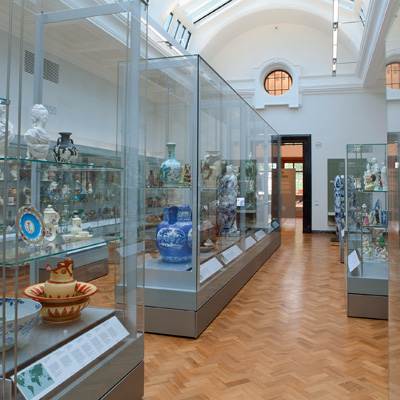Building on future plan
As the director of the Victoria & Albert Museum, Sir Mark Jones, steps down, where next for the South Kensington treasure trove that he helped transform? Emily Gosling looks back at his achievements – and ahead to the future

Last week, Victoria & Albert Museum director Sir Mark Jones announced he is to leave the museum, where he has worked since 2001, to become Master of St Cross College, Oxford.
The V&A trustees are now beginning the search to find a new director.
The past decade has seen 70 per cent of the museum renovated under Jones’ direction, as part of the ambitious Future Plan project.
The £120m project – the biggest re-shaping of the museum in 50 years – aims to transform the V&A by revitalising visitor facilities and redisplaying the collections, bringing modern design and innovation to the fore.
The period of transformation has included the opening of the Medieval and Renaissance Galleries, designed by McInnes Usher McKnight Architects in 2009; the opening of the Sackler Centre for arts education, designed by Softroom in 2008; and the transformation of the central hall into the main museum shop, which was completed by Eva Jiricna Architects in 2006.
The Ceramics, Buddhist Sculpture, Theatre and Performance, and Gilbert Collection galleries all opened in 2009.
Jones says, ’The V&A has continued to do something that started well before my time with Sir Roy Strong [former director at the museum], which is to get back in touch with its origins.
’There’s a special focus on being a resource for creative designers and a place where people can go for ideas. It’s a museum which gets people thinking about design in all its forms.’
I’ve enjoyed making small things happen, like the beautiful escape bridge from the Ceramics Galleries
Sir Mark Jones, Victoria & Albert Museum
In 2012 work will begin on the new outpost for the V&A in Dundee, which will be situated in a new building on the River Tay. Japanese architectural practice Kengo Kuma & Associates won a competition to design it earlier this month.
This week Amanda Levete and Tony Fretton Architects were among seven practices shortlisted in a competition to find a design team to create a new building to house its London exhibition galleries, with a new courtyard and entrance on to Exhibition Road. This would succeed plans for a scheme drawn up by Daniel Libeskind, which was ditched in 2004 due to lack of funding. More than 100 teams expressed an interest in the competition, from as far away as Seoul, São Paulo and Los Angeles.
Jones says of his achievements, ’I don’t know about my legacy. I do know that people enjoy visiting, and that people notice that the objects are beautifully shown in beautiful spaces.
’In restoring the museum and rethinking the collections we’ve worked with a range of interesting and highly talented designers who have been faithful to those who created the V&A, working with its history in terms of its purpose and the complicated and elaborate building.’
The V&A director shoes will certainly be large – and difficult – ones to fill. Jones says, ’It’s a recognised brand with an international reputation – the biggest challenge is to ensure it remains a genuinely world-class museum.’
For the future, Jones envisages the V&A’s reach continuing to span well beyond its South Kensington walls, increasing its global presence online and through its many touring exhibitions.
He says, ’I’ve enjoyed making small things happen, like the beautiful escape bridge from the Ceramics Galleries [designed by Wilkinson Eyre Architects]. People might think it’s just a fire escape, but it’s a very beautiful piece of design.
’The pleasure of working at the V&A is the opportunity to make things happen – to make something quite ordinary quite exceptional.’

_Voxpop
What are the biggest challenges facing Mark Jones’ successor as director of the V&A?
Mark Jones has imprinted his quiet discipline and learned authority at the museum and leaves us this treasure house and original national design museum so very much better than he found it. His tenure has been outstanding. Of future challenges there will doubtless be many – I highlight three: First, maintaining the museum’s rising trajectory and standards in the face of the nation’s straightened circumstances. Second, winning what will become an increasingly competitive race for private sponsors to fund the museum’s needs and potential. Third, and true to its original purpose, a continuing commitment to design as an integral component of the museum’s leadership role in our cultural and commercial landscape.
Rodney Fitch, Consultant
To be brave and bold and not get bogged down – the V&A still needs the most fabulous fashion gallery in the world, an international 20th-century design gallery and to do something about the gorgeous Indian collections languishing in store.
Gwyn Miles, Director, Somerset House Trust
V&A timeline
2002 – Contemporary Gallery, designed by Gareth Hoskins Architects, completed
2003 – Cromwell Road Grand Entrance remodelled
2004 – V&A RIBA Reading Rooms and Stores, designed by Wright & Wright Architects created. Daniel Libeskind’s Spiral extension scheme ditched
2005 – The John Madejski Garden opened, designed by Kim Wilkie Associates
2006 – V&A Museum of Childhood opened in Bethnal Green, designed by Caruso St John Architects
2007 – Contemporary Space Gallery opened, designed
by Block Architecture
2008 – Sackler Centre for arts education opened, designed by Softroom
2009 – Ceramics Link Bridge completed, designed by Wilkinson Eyre Architects; Medieval and Renaissance Galleries completed by McInnes Usher McKnight Architects
2010 – Ceramics Study Galleries completed, designed by Opera Amsterdam. Kengo Kuma wins competition to design Dundee outpost. Contest to design new extension launched
-
Post a comment




